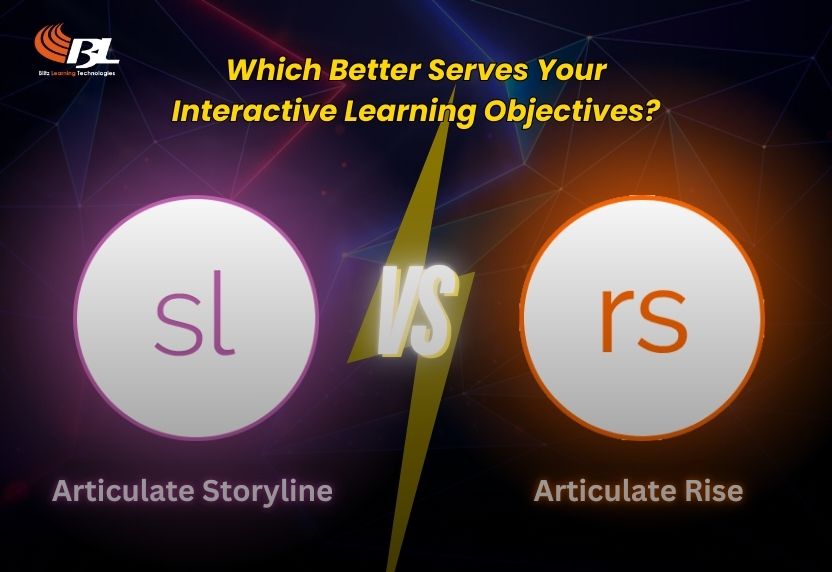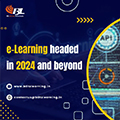
Blog
- Home
- Blog

24Sept
Articulate Storyline vs Articulate Rise: Which Better Serves Your Interactive Learning Objectives?
Introduction
In this fast-evolving world of e-learning, choosing the right authoring tool significantly impacts the effectiveness and level of engagement in your interactive learning modules.
When it comes to developing interactive eLearning content, there are two main striking tools: Articulate Storyline and Articulate Rise. Each of these products has certain distinctive features which make it more advantageous than others. The choice depends on your current project needs. This comparison will discuss the two eLearning development options, Articulate Storyline and Articulate Rise, from a traditional and modern perspective, respectively, to guide you in selecting a tool best fitting for your interactive learning needs.
Traditional vs. Modern Approaches
Articulate Storyline-a long-standing player in the eLearning market offers a traditional approach with a comprehensive array of features and functionalities for detailed design. On the other hand, Articulate Rise was launched in 2016, embracing modern responsive design to meet emerging needs for mobile-friendly content.
Customization and Flexibility
Articulate Storyline shins whenever the topic of customization comes up; thus, it's the go-to tool when you would want to develop a course that is highly customized. Supporting complex elements such as interactive simulations, branching scenarios, and complex animations, it features a timeline-based interface that will allow easy incorporation of quizzes, multimedia, and animations. If you're an experienced eLearning developer who wants to create richly interactive content with deep customizations, Storyline will help you create from scratch.
On the contrary, Articulate Rise makes course content creation easy by facilitating the drag-and-drop features. Ideal for text-heavy and templated content, Rise features a set of inbuilt templates and content blocks that help developers create visually interesting courses in record time. It may not be as customizable as Storyline, but its ease of use makes it very useful in churning out efficient content in record time.
Development Time
Articulate Rise boasts faster development times because of pre-built templates and content blocks. This efficiency is particularly useful when projects have a tight deadline or when frequent updates are needed. By contrast, Articulate Storyline has a more time-consuming development process whereby its many ways of customizing the project within it and setting it up manually work better in fitting projects with a high level of interactivity and complexity.
Mobile Experience
Articulate Rise is quite commendable when it comes to mobile responsiveness, and this is easily compatible with automatic adjustments to different types of devices: smartphones, tablets, and desktops. As such, the learning experience will be virtually seamless across all devices. Articulate Storyline is a much stronger tool but is less optimized for mobile responsiveness; thus, it will work better on desktops and laptops.
Mobile ExperienceHow to Choose Between Them: Key Considerations
1. Project complexity : First, there is the complexity of the project. If your course requires high levels of interactivity, custom animations, and intricate simulations, then you will most likely want to use the advanced features of Articulate Storyline. If you need to develop simple, responsive content in record time, then Articulate Rise offers a more efficient solution.
2. Design resources and timeline : Now, consider your design resources and timeline. Articulate Storyline is a more complex tool and hence requires much more time and skill to use it properly. If you have a complete design team and are not pressed for time, then Storyline will be able to provide you with highly customized results. On the other hand, Articulate Rise proves best for the team with limited design resources or less time since it provides a quick and easy way to create high-quality e-learning content.
3. Learner experience : Think about the learner experience you want to achieve. Articulate Storyline enables you to create an overwhelmingly engaging and interactive experience, so it is fitting for scenarios that call for active participation. Articulate Rise brings mobile-responsive design and streamlined approach, excellent for easily accessible engaging content on multiple devices.
4. Budget and resources : Finally, bring into account your budget and resources. Advanced capabilities with Articulate Storyline may mean higher costs and larger learning curves, whereas generally more cost-effective and easier to use, Articulate Rise, may not offer all of those advanced features of Storyline. Evaluate what aligns best with your budget and resource constraints.
Conclusion
Both Articulate Storyline and Articulate Rise have impressive features, which work well for different needs in eLearning. Storyline is unparalleled for advanced interactivity and customization, making it ideal for complex courses. Rise is particularly well-suited for rapid development of effective, accessible learning where there is a concern for ease of use and mobile responsiveness. Considering the complexity of your project, your design resources, the desired learner experience, and your budget will let you decide which tool is the best fit for your interactive learning needs. Both Storyline and Rise give major ammunition for efficiently creating impactful eLearning content.

Neha Khare
About authorNeha Khare specializes in designing engaging and effective learning experiences tailored to learners' needs and also creates insightful blogs on corporate e-learning. She develops creative instructional methods, integrates multimedia, and aligns content with learning goals. Neha's innovative techniques and blog contributions significantly enhance the quality and impact of corporate training programs.



Leave a comments